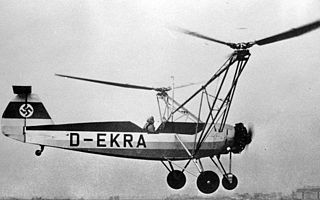
The Focke-Wulf Fw 61 was the first successful, practical, and fully controllable helicopter, first flown in 1936. It was also known as the Fa 61, as Focke began a new company—Focke-Achgelis—in 1937.

The MBB/Kawasaki BK 117 is a twin-engined light utility–transport helicopter. It was jointly developed and manufactured by Messerschmitt-Bölkow-Blohm (MBB) of Germany and Kawasaki of Japan. MBB was later purchased by Daimler-Benz and eventually became a part of Eurocopter, which was later rebranded as Airbus Helicopters.

The EurocopterAS365 Dauphin (Dolphin), also formerly known as the Aérospatiale SA 365 Dauphin 2, is a medium-weight multipurpose twin-engine helicopter produced by Airbus Helicopters. It was originally developed and manufactured by French firm Aérospatiale, which was merged into the multinational Eurocopter company during the 1990s, and since 2014 Eurocopter was renamed Airbus Helicopters. Since entering production in 1975, the type has been in continuous production for more than 40 years, with the last delivery in 2021. The intended successor to the Dauphin is the Airbus Helicopters H160, which entered operational service in 2021.

The EurocopterEC120 Colibri ("hummingbird") is a five-seat, single-engine, light utility helicopter. Jointly designed and developed by Eurocopter, China National Aero-Technology Import & Export Corporation (CATIC), Harbin Aviation Industries (Group) Ltd (HAIG) and Singapore Technologies Aerospace Ltd (STAero) at Eurocopter France's Marignane facility, the EC120B was assembled by Eurocopter in France and Australia.

The Colomban Cri-Cri, also spelled Cricri, is the smallest twin-engined crewed aircraft in the world, designed in the early 1970s by French aeronautical engineer Michel Colomban.

The Airbus Helicopters H135 is a twin-engine civil light utility helicopter produced by Airbus Helicopters, formerly Eurocopter. It is capable of flight under instrument flight rules (IFR) and is outfitted with a digital automatic flight control system (AFCS). First flying in February 1994, it entered service in 1996. 1,400 have been delivered up to September 2020, to 300 operators in 60 countries, accumulating over 5 million flight hours. It is mainly used for air medical transport (medevac), corporate transport, law enforcement, offshore wind support, and military flight training. Half of them are in Europe and a quarter in North America. The H135M, certified under the name Eurocopter EC635, is a military variant, so the overall design is known as the Airbus Helicopters H135 and the military version, as the Airbus Helicopters H135M. The EC135/H135 is a development of the earlier Messerschmitt-Bölkow-Blohm (MBB) Bo 105.
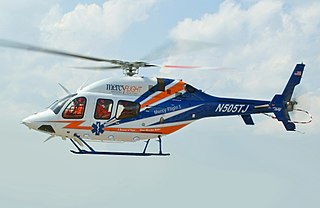
The Bell 429 GlobalRanger is a light, twin-engine helicopter developed by Bell Helicopter and Korea Aerospace Industries. The first flight of the prototype took place on February 27, 2007, and the aircraft received type certification on July 1, 2009. The Bell 429 is capable of single-pilot IFR and Runway Category A operations.

The Airbus Helicopters H145 is a twin-engine light utility helicopter developed and manufactured by Airbus Helicopters. Originally designated as the BK 117, the H145 is based upon the MBB/Kawasaki BK 117 C1, which became a part of the combined Eurocopter line-up in 1992 with the merger of Messerschmitt-Bölkow-Blohm's helicopter division of Daimler-Benz into Eurocopter. The helicopter was initially named EC145; an updated version, EC145 T2, was renamed H145 in 2015. The helicopter was significantly updated in the 2020s with first a fenestron replacing the traditional tail rotor, followed later by a 5-blade main rotor head.

The Cirrus Vision SF50, also known as the Vision Jet, is a single-engine very light jet designed and produced by Cirrus Aircraft of Duluth, Minnesota, United States.

The Airbus Helicopters H175 is a 7-ton class super-medium utility helicopter produced by Airbus Helicopters. In China, the H175 is produced by the Aviation Industry Corporation of China (AVIC) as the Avicopter AC352. Originally launched as the Eurocopter EC175 and the Harbin Z-15, it has been referred to as being a 'super-medium' helicopter.

The McDonnell XV-1 is an experimental Convertiplane developed by McDonnell Aircraft for a joint research program between the United States Air Force and the United States Army to explore technologies to develop an aircraft that could take off and land like a helicopter but fly at faster airspeeds, similar to a conventional airplane. The XV-1 would reach a speed of 200 mph, faster than any previous rotorcraft, but the program was terminated due to the tip-jet noise and complexity of the technology which gave only a modest gain in performance.
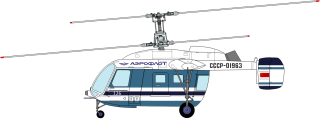
The Kamov Ka-126 is a Soviet light utility helicopter with co-axial rotors. Evolved from Ka-26 with engine pods removed from stub wings, fitted with one TVO-100 turboshaft engine positioned on top of fuselage, modified rotor blades, new fuel system.

The Kellett XR-10 was a military transport helicopter developed in the United States in the 1940s that only flew in prototype form. It was designed in response to a USAAF Technical Instruction issued for the development of a helicopter to transport passengers, cargo, or wounded personnel within an enclosed fuselage. Kellett's proposal followed the general layout that the company was developing in the XR-8, with twin intermeshing rotors, and was accepted by the Air Force on 16 October over proposals by Sikorsky, Bell, and Platt-LePage.

The Harbin Z-19 is a Chinese light reconnaissance/attack helicopter developed by Harbin Aircraft Manufacturing Corporation (HAMC) for the People's Liberation Army Air Force and the Ground Force Army Aviation. It is a specialized combat variant of the Harbin Z-9, which is a license-built version of the Eurocopter Dauphin.

The Bell 525 Relentless is an American super-medium-lift helicopter, under development by Bell Textron. The Bell 525 was unveiled at the 2012 Heli-Expo in Dallas, Texas in February 2012. The helicopter first flew on 1 July 2015. It is designed to transport up to 19 passengers. The aircraft is the first fly-by-wire civilian aircraft and suffered a crash of its prototype, and is still slowly working towards certification. As of 2024, Bell is still working towards completing flight certification it has secured its first order.
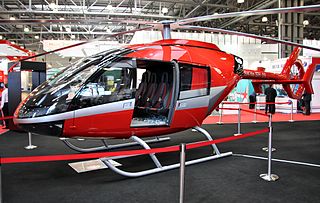
The Kopter AW09 is the Leonardo Helicopter Division's five-to-eight seat, single-engine multirole helicopter which is currently under development at Kopter’s facilities. It is a clean-sheet design amongst a market sector dominated by decades-old airframe designs.

The Airbus Helicopters H160 is a medium utility helicopter developed by Airbus Helicopters. Formally launched at Heli-Expo in Orlando, Florida on 3 March 2015, it is intended to replace the AS365 and EC155 models in the firm's lineup. In June 2015, the first test flight took place. It received its EASA type certification in July 2020, and first deliveries were in December 2021.

The Airbus Helicopters VSR700 is an unmanned reconnaissance helicopter being developed by Airbus Helicopters.

The Advanced Heavy Lifter is a large helicopter project developed by Aviation Industry Corporation of China.
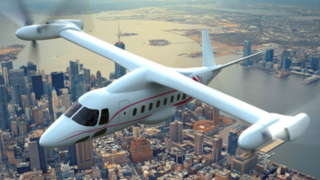
The Leonardo Next-Generation Civil Tiltrotor is a tiltrotor aircraft demonstrator designed and developed by the Italian aerospace company Leonardo S.p.A. Studies for a two times larger tiltrotor than the AgustaWestland AW609 started in 2000. Since 2014, its development is sponsored by the European Union's Clean Sky 2 program. By May 2021, major components were under production By 2023, the maiden flight had been pushed back to 2024, from a 2020 initial plan.




















